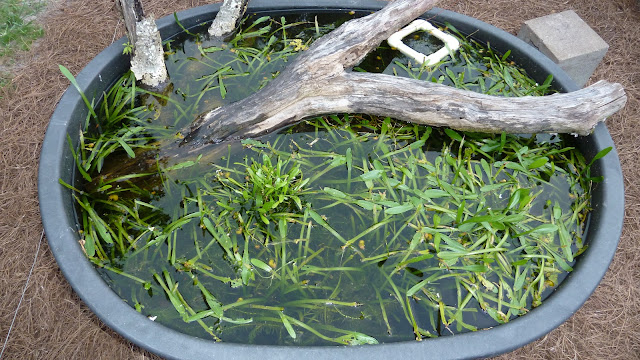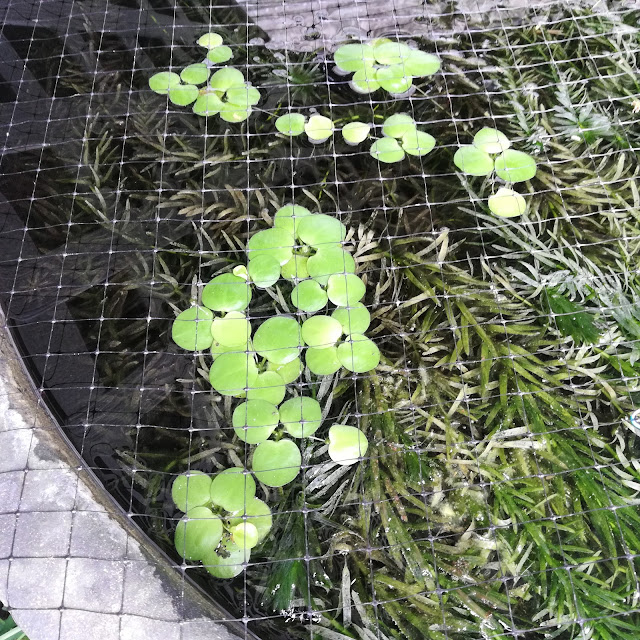I purchased this batch from eBay. It was in rough shape when I received it. I scattered the bits and pieces among all my tanks. It grew, but the leaves would yellow and die faster than the new ones could grow. Eventually it all died except for two of my stock tanks.
I had frogbit previously and it grew like mad until the armyworms found it.
Saturday, September 26, 2020
Aquarium 110 Gallon Stock Tank Amazon Frog Bit
For a while, I thought the Amazon Frogbit was all going to die. As the weather cooled off some, it has started to grow again.
Saturday, June 13, 2020
Whitecloud Fry In My 100 Rubbermaid Stock Tank
I've had Whiteclouds in this stock tank for several years. They spawned some in the past and produced a few fry. This year they spawned a lot. The area in the video is maybe eight inches across. The fry seems to be everywhere you look. No filters, water changes, air stones, and only a pinch of flake food when the weather is warm none during the winter or rainy days.
Thursday, June 4, 2020
300 Gallon Rubber Maid Stock Tank With Bluefin Killifish, Bronze Corydoras, and shrimp
 |
| 300 Gallon Rubber Maid Stock Tank With Bluefin Killifish, Bronze Corydoras, and shrimp. |
Much of the test is from answering questions on a Facebook group.
My 300-gallon stock tank is greening up again. Green water isn't a bad thing. Green water can be an excellent food source for tiny fry and makes fry more difficult for the adults to find and eat them. It does make it hard for me to see the fish.
I added a 12 Bronze Corys a few days ago. Two were adult females that were laying a large number of eggs without a male. I wanted to use some albinos I have that seem to want to spawn every morning, but I was afraid that they would be to easy for a predator to see when they come up for air. In the green water, the Bronze Corys are almost invisible.
I don't use filters, no moving water, no water changes except when it rains. I do add water to keep the tank full.
If you have fish in the tank, you are not going to have mosquito larvae. Not for long anyway. Mosquito larvae will get eaten as well as just about any insect that gets into the water. If you have surface feeders, they will attack insects on top of the water.
It takes a while for the tank to become established. Once it does and the plants are growing well, the water is clear.
I would add that if you are going to do this, stock tanks are the way to go. The sun will burn up wading pools and plastic tubs. It would be best if you had as much shade as possible. Full shade all day, if possible. Full sun will cook your fish.
They design stock tanks for watering large animals on a farm. They make them form plastics that will sit in the sun for years without falling apart and withstand abuse from horses, cows, goats, and other farm animals. They have a drain built into them. I have one running now that has been in constant use since 2004.
A tub or tote you get from Walmart is made from cheap thin plastic that will not hold up to the sun. These tubs are not designed to hold water, and the sides will bulge. If the rim should split under pressure and sometimes do, you could come home to find your fish dumped out on the ground. A large animal, dog or raccoon, could easily tip one over or break it.
Wading or kiddie pools are a little better. They will hold water well, but they will not last long. The edges will split eventually, and once that happens, the pool is toast. The shallow ones heat up very fast if they get any sun at all.
If you have fish in the tank, you are not going to have mosquito larvae. Not for long anyway. Mosquito larvae will get eaten as well as just about any insect that gets into the water. If you have surface feeders, they will attack insects on top of the water.
It takes a while for the tank to become established. Once it does and the plants are growing well, the water is clear.
I would add that if you are going to do this, stock tanks are the way to go. The sun will burn up wading pools and plastic tubs. It would be best if you had as much shade as possible. Full shade all day, if possible. Full sun will cook your fish.
They design stock tanks for watering large animals on a farm. They make them form plastics that will sit in the sun for years without falling apart and withstand abuse from horses, cows, goats, and other farm animals. They have a drain built into them. I have one running now that has been in constant use since 2004.
A tub or tote you get from Walmart is made from cheap thin plastic that will not hold up to the sun. These tubs are not designed to hold water, and the sides will bulge. If the rim should split under pressure and sometimes do, you could come home to find your fish dumped out on the ground. A large animal, dog or raccoon, could easily tip one over or break it.
Wading or kiddie pools are a little better. They will hold water well, but they will not last long. The edges will split eventually, and once that happens, the pool is toast. The shallow ones heat up very fast if they get any sun at all.
Labels:
300 Gallon Stock Tank,
Anacharis,
Anubias,
Bluefin Killifish,
Breeding,
Bronze Corydoras,
Corydoras,
Dwarf Sagitarius,
Frogbit,
Native Fish,
Plants,
Sagitarius,
Stock Tank,
Tubbing
Thursday, May 28, 2020
White Cloud Mountain Minnow Colony In A 100-gallon Rubbermaid Stock Tank
My hundred-gallon rubber made stock-tank, Home for my Whitecloud colony. They have been outdoors in this tank for around three years. There are several sizes of fry in there now and an unknown number of adults.
The plants are mostly dwarf sagitarius. There is a large clump of java moss and a few amazon frogbit plants I reciently added. The top is covered with birdnetting to keep my resident red sholdered hawk out,
Stocking Suggestions For a 100 Gallon Stock Tank
 |
| 100 Gallon Tuff Stuff Stock Tank |
White clouds if you want the to survive the winter.
Guppies are good while the temperature is above 60 degrees. Guppies are pretty easy to catch. This is especially true if you have been feeding them.
Platies can't take the heat or the cold well. They can work, but you need to keep them in a shaded area.
You don't want direct sun if you can avoid it.
I have kept Peppered Corydoras paleatus. and albino bristle nose outside in the summer.
Light colored fish are easy to see. Goldfish or the golden white clouds for example. Regular white clouds just about disappear in the black stock tank. Peppered Corys will vanish and not be found again until you drain the tank.
All of the zebra danios I have in my aquariums were spawned in media mixing pans outdoors like the ones you would use for mixing mortar.
There is a theme here. Hardy fish are usually the cheap ones. I would like to try some native sailfin mollies and bluefin killies. These are native to our area and should do well.
Put wire fencing over the top of the tank high enough above the water level that birds can't perch on the wire and eat you fish. I had a red shouldered hawk clean out a tank once.
Raccoons and the neighborhood kids are a real threat.
Sunday, February 2, 2020
Okefenokee Pygmy Sunfish Elassoma Okefenokee
I have pygmy sunfish. They Stay hidden most of the time and are very hard to find. If you watch all the way to the end you will see the fish almost vanish as it nears the bottom. The spots are electric blue on a dark background. The fish seem to be able to turn them on at will. When he flares the blue areas are very bright. Very much like the blue on a neon tetra. They are tiny and like to hide in the plants and under rocks and leaves making them very difficult to catch. This adult fish is about 34/-inch long.
The Okefenokee pygmy sunfish, Elassoma Okefenokee, is a species of pygmy sunfish found in southeastern United States, where it prefers waters with dense vegetation growth in the Altamaha drainage in southern Georgia south to Lake Okeechobee, Florida, interior lake basins in north-central Florida, and upper Suwannee, Withlacoochee, and Hillsborough river drainages on the Gulf Coast of Florida. This species can reach 3.4 cm (1.3 in) in total length.
https://en.wikipedia.org/wiki/Pygmy_sunfish
The Okefenokee pygmy sunfish, Elassoma Okefenokee, is a species of pygmy sunfish found in southeastern United States, where it prefers waters with dense vegetation growth in the Altamaha drainage in southern Georgia south to Lake Okeechobee, Florida, interior lake basins in north-central Florida, and upper Suwannee, Withlacoochee, and Hillsborough river drainages on the Gulf Coast of Florida. This species can reach 3.4 cm (1.3 in) in total length.
https://en.wikipedia.org/wiki/Pygmy_sunfish
https://en.wikipedia.org/wiki/Heterandria_formosa
Subscribe to:
Posts (Atom)

